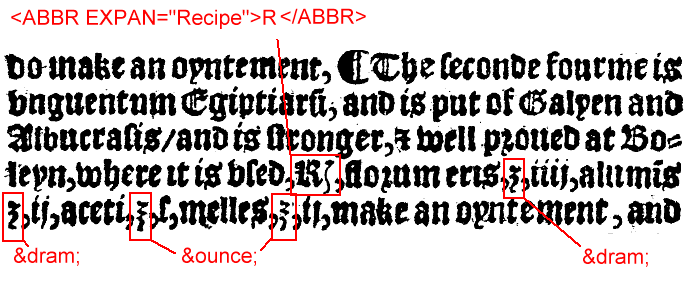Example: planetary symbols, which stand for the planets in astrological books but for metals in alchemical books.
Policy: these are in some sense the same symbols, since those who used them in one sense were aware of the connections to the other sense. Use the same signs for both meanings; e.g., represent the sun/gold sign as "&sun;" regardless of whether it means "sun" or "gold" in context.
Comment: I'll add the chemical meanings to the main table of these in the keying instructions.
Example: a triangle pointing upwards may be a capital Greek letter delta; a symbol for the astronomical position called "trine"; an alchemical symbol for "fire"; and probably other things as well.
Policy: distinguish these uses if we can.
Example: Middle English yogh (the character shaped roughly like a "3") persists in some early modern (especially Scottish) books as "z".
Policy: Generally, leave these as the characters that they now pretend to be, since it would be both anachronistic and difficult to undo the merger that has taken place. (But see: the special case of "z", below).
Example: the "quod" symbol (&abquod;) is frequently used in English contexts to mean "quod" or "quoth" (= "said").
Example: many symbols of Latin origin are used to stand for vernacular equivalents, e.g. "d." for "pence" or & for "and".
Policy: capture them as they appear.
Example: the usual symbol for "-is" or "-es" (which we call &abis;) has been found following "R" to mean "Recipe," apparently as a generic abbreviation stroke (R~); "sz" which can often mean "sed", has been found also in the sense "semis"; the symbol that can mean "ser" (our &abser;) can also mean "semis" and (preceded by "ro-") "rosae" or some such; and the familiar crossed-R prescription symbol (℞ for "Recipe") can, in the combination "A.℞." mean "Aqua Regis". . "-r" in the abbreviation "qr" probably derives from one meaning of the combination ("quare"), but "qr" also came to mean "quia" in which the case the "r" has in effect become an abbreviation stroke. The familiar use of ";" as part of of the "-que" abbreviation may also fall into this category. Some of the symbols may in fact always be functioning as generic abbreviation strokes; but &abis; and "r" at least do have specific meanings which are apparently ignored when they are used generically.
Policy: let the vendors capture the symbols as best they can based on their shape. In review, where it is possible to identify generic (or even specific) uses, treat them as generic abbreviation marks, ideally with an EXPAN attribute. E.g.:
| abbrev. | meaning | capture as: | convert to: |
|---|---|---|---|
| &Virgo; or &Scorp; | minim ('drop') | &Virgo; or &Scorp; | <ABBR>M</ABBR> if possible |
| R&abis; | Recipe | R&abis; | <ABBR EXPAN="Recipe">R</ABBR> if possible |
| A.℞. | Aqua Regis | A.℞. | <ABBR EXPAN="aqua regis">A.R.</ABBR> |
| sz | sed or semis or ? | &sed; | <ABBR EXPAN="semis">s</ABBR> or &sed; as appropriate, if possible |
| &abser; | ser or semis or s...? | &abser; | <ABBR EXPAN="semis">s</ABBR> or <ABBR>ros</ABBR> or &sed;, etc., as appropriate, if possible |
| qr | quia (or quare?) | qr | <ABBR>qr</ABBR> or <ABBR EXPAN="quia">qr</ABBR> etc. if possible |
| ...q; | ...que (except for "esq;" = "esquire") | ...&abque; | ...&abque; or <ABBR>esq</ABBR> as appropriate |
For cases in which an 'incorrect' symbol is used based on some superficial similarity of form (perhaps because of the printer's lack of the correct piece of type), or where there is no 'base' character to the symbol that will allow use of ABBR tags, see the document on hijacked symbols.
Example: "z"-like characters appear in several circumstances: "z" follows "q" to form one variant of &abque;; "z" follows "s" to form the symbol we call &sed; but which may simply mean <ABBR>s</ABBR>; as the last letter in a word, "z" may be a form of "-m"; "z" can form part of at least two common abbreviations, "viz." (videlicet) and "scz." (scilicet). Our policy to date on these has been as follows:
| abbrev. | meaning | capture as: |
|---|---|---|
| viz. | videlicet | viz. |
| scz. | scilicet | <ABBR>sc</ABBR> or scz |
| -sz | -s or -ss [in Scots texts] | -sz |
| sz | sed or semis (etc.?) | &absed or <ABBR EXPAN="semis">s</ABBR> as appropriate |
| qz | -que | &abque; |
Some real examples
See also some of the examples in the Latin abbreviations examples page and the hijacked symbols page.


